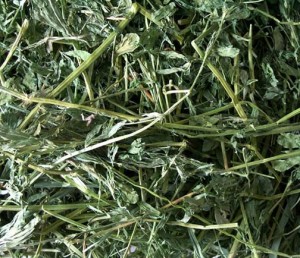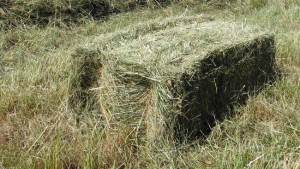Hay for Horses- Part 1
I am horrified how many horse owners have said to me “But isn’t Hay just Hay?” or “Isn’t all Hay the same?”
The answer is a loud, resounding “NO!” Not all hay is created equal, especially when it comes to horses. The main issue with hay is that the quality can vary from very good to very bad, with poor quality hay risking making your horse sick, including potentially fatal illnesses such as colic or laminitis.
So today let’s start at the beginning…
HOW MUCH HAY DO HORSES EAT?
Horses consume 2-2.5% of their body weight in dry matter daily. Forage in the form of hay and hay cubes will comprise 50-100% of the dry matter requirements.
Therefore, a 1000 lb. mature horse can be expected to consume 22-24 lb. of hay daily on an as fed basis. (1000 lb. x 2% or 1000 lb. x .02 = 20 lb. of dry matter.
Hay is 90% dry matter; therefore, 20 lb. of dry matter is equal to 20 x 100/90 = 22 lb. of hay on an as fed basis).
Assuming that a small square bale of hay weighs 50 lb., this represents about ½ a bale of hay per day per mature 1000 pound horse. (For the purposes of this article, the term “bale” refers to a 50 lb. small square bale of hay.
However, there is a large variation in bale weight from as low as 30 lb. up to 60 lb. Therefore, it is best to weigh a number of bales and get an average for your hay.)
TYPES OF HAY
ALFALFA
Alfalfa hay is higher in protein than the other types of hay. Adult horses don’t need a lot of protein so alfalfa hay is not the best choice of hay for an adult horse. Mares that are pregnant or have young foals should be fed alfalfa because of the higher protein and nutritional content. Alfalfa hay can be hard to find and expensive, so unless your horse needs a lot of protein you can usually select a cheaper, easier to find type of hay to feed your horse.
TIMOTHY
Timothy hay is the hay that is most often fed to horses. Timothy hay has a good blend of the nutrients that horses need and it’s easy to find because it’s grown just about everywhere in the country. Timothy hay is actually a blend of Timothy grass and other plants so if you have outdoor allergies you might find that you react badly to the pollen in Timothy hay. Many people that don’t suffer from allergies do find that they have allergy problems around Timothy hay.
Local Grass / Orchard Hay
Grass/Orchard Grass hay is a mix of several pasture grasses. Orchard Grass hay is often the least expensive type of grass because it requires the least amount of cultivation. Since it has a lower nutritional content, horses will need to eat more Orchard Grass hay than other types of hay to get the same nutrition. If your horses are kept in a pasture and the grass forage gets low, it’s a good idea to mix some Timothy hay and some Orchard Grass hay and feed both kinds to keep the horses interested and to give them the nutrition they need.
What type of Hay is Right for Your Horse?
Just like people have different tastes in food some horses will have different tastes in hay. If your horse doesn’t like one type of hay or seems to lose weight or gain weight too quickly eating one type of hay, you might have to try another. A good place to find information about where to find hay locally is at the local agricultural feed store.





